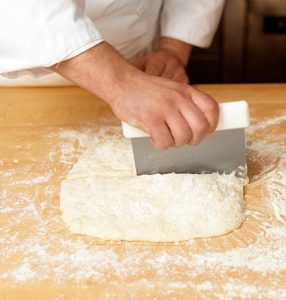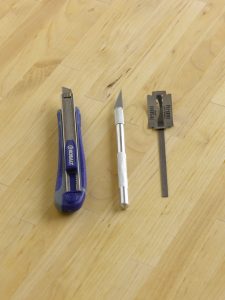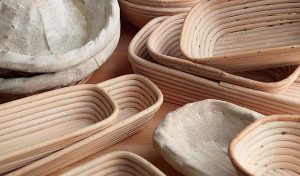Like most hobbies, making breads at home can lead to purchase after purchase. The accessories are seemingly endless and it’s hard to resist a new hand tool or piece of equipment (we get it!), but do you really need them?
When it comes to bread, a technique that dates back to more than 14,000 years, you don’t need much. Flour, water, salt, and an oven will get you a long way for a naturally fermented sourdough or rustic country loaf. But a lot has changed in 14,000 years, and today, there are modern conveniences that make the process of bread baking easier and more efficient, and who doesn’t love that?
Here, we’ll talk through a few bread accessories, tools, and equipment that we think are worth the buy.
Stand Mixer
Stand mixers are an investment, but if you are making bread regularly (plus any other baking), the savings in time and effort pay for themselves over time. Plus, most of the popular brands have great warranties and are easily repaired, so it’s usually a piece of equipment you can keep for the long haul (our editor’s is more than 15 years old with no signs of slowing).
Bread can be tough on a mixer, and some brands make “professional” styles that have stronger motors and bigger bowls. If you make a few loafs every week, it might be worth investigating these options—but it’s not necessary.
Dutch Oven
Because our home ovens aren’t designed for bread baking—high temperatures, venting, plus the addition of steam—we make some accommodations to recreate that environment as much as possible. Baking your rustic loaves in a heavy, pre-heated Dutch oven is one of the most popular ways to achieve close-to-professional results in your everyday kitchen.
You don’t have to splurge on this, either. Often when people discuss Dutch ovens, some big and expensive brands come to mind. We like those, too, but you can find a really good quality, cast-iron Dutch oven for under $100. You may even have a heavy-bottom stainless steel saucepan that can do the job, too! Whatever you get, make sure it’s nice and heavy, fully oven safe, and has handles on both the pot and lid so you can easily maneuver it when it’s piping hot.
Spray Bottle
A $1 store special, a simple spray bottle is a great convenience when baking bread. Filled with water, you can use it to lightly hydrate dry dough as you mix (no risk of adding too much) and spritz the loaves just before baking to help produce steam. A second bottle filled with vegetable oil is also handy for greasing your bowls or oiling your hands for a particularly sticky dough. It may not seem like much, but next time you’re baking, make a note every time you turn on the sink or have to uncap a bottle of oil.
Bench Scraper

A bench scraper is one of those tools that transitions seamlessly from “nice to have” to “can’t bake without it.” In bread making, it helps you divide dough cleanly, move sticky masses from counter to bowl, and keep your work surface tidy without adding excess flour. A metal scraper is the most durable and easiest to clean, and because they’re inexpensive, this is a low-risk, high-reward tool for any home baker.
Digital Scale
If you’re getting more serious about bread—especially naturally leavened loaves—a digital scale becomes essential. Measuring by weight is more accurate than using cups and spoons, and for dough, even tiny adjustments can change hydration levels and texture. A small, reliable scale doesn’t have to be expensive, and it will instantly make every recipe you bake more consistent. If you’re troubleshooting or getting into the finer details, you may also benefit from a micro-scale, which measures very small amounts and can help you refine quantities of yeast, salt, or other ingredients.
Lame or Sharp Razor

Scoring is more than decoration; it helps guide the expansion of your dough in the oven so it rises upward, not sideways. A baker’s lame, or even just a razor blade attached to a wooden coffee stirrer or a super sharp craft knife gives you the control you need for clean slashes. Look for something extremely sharp and easy to hold—nothing fancy required, and be sure its keep it as a dedicated kitchen razor. Extra tip: if you are searching for a great gift for the bread-baker in your life, look for artisanal, hand-made lames from local woodworkers. They will be beautiful and incredibly useful.
Proofing Baskets (Bannetons)

While totally optional, a proofing basket helps shape and support wetter doughs during their final rise. The ridges also create attractive spiral patterns on your finished loaf. If you bake sourdough often, one or two bannetons in different sizes can be useful. If you don’t, a bowl lined with a floured kitchen towel works just as well.
Tools That Aren’t Worth Buying (Really!)
With bread baking, it’s easy to get swept away by specialty gadgets. Here are a few you can confidently skip—your loaves won’t suffer for it.
Specialized “Bread Mats” or Custom Silicone Liners
These are marketed as nonstick and “temperature optimized” for bread, but they don’t create the crisp bottom or even heat you get from parchment, cast iron, or a baking stone. They’re also harder to fully clean and tend to warp or discolor over time.
Bread Machines (for most bakers)
While some people love them, a bread machine often ends up taking more space than it’s worth. They offer limited control over fermentation and shaping—two of the key parts of bread making—and the final loaf is usually inferior to what you can produce with a bowl, your hands, and your oven. If you’re excited about learning technique, you’ll outgrow a bread machine quickly.
Single-Purpose Dough Risers or “Bread Proofing Boxes”
These bulky warmers are essentially small warming ovens, but your regular oven, or even just your countertop, works perfectly for proofing. Unless you bake commercially or have extremely cold kitchen conditions, these devices mostly gather dust.
Decorative Shaping Gadgets
Any tool that promises picture-perfect braids, twists, or coils with a single press tends to do the opposite. Bread dough is soft and variable, and these plastic molds rarely work as advertised. Good shaping comes from practice, not a gadget.
Electric Dough Mixers/“Dough Whips” That Claim to Replace Your Hands
These small electric whisks or spiral mixers often struggle with stiff doughs and can over-mix softer ones. Hand mixing or a stand mixer will always give you better, more controlled results.
Bread baking is one of the oldest crafts in the world, and while modern tools can certainly make the process easier, none of them are required to create beautiful, delicious loaves at home. The most important “equipment” you’ll invest in is time—time to learn the dough, to practice shaping, and to enjoy the small victories that come with each bake. Choose the tools that truly support the way you like to bake, skip the ones that overpromise, and remember that great bread has always come from simple ingredients, simple techniques, and the hands of a patient baker.


